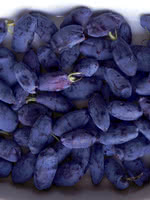Mon-Fri 9am - 5pm Mountain time
Honey Bee Haskap (Honeyberry) vs Blue Treasure Haskap (Honeyberry)
Lonicera caerulea Honey Bee
Lonicera caerulea Blue Treasure
NOT AVAILABLE THIS SEASON - MIGHT RETURN
NOT AVAILABLE THIS SEASON - MIGHT RETURN
Honey Bee Haskap produces tarter fruit than the Aurora and Borealis varieties and is known for bearing fruit at a younger age. The flavour of Haskaps is generally described as a cross between a blueberry and a raspberry. Honey Bee Haskaps are well suited to fresh eating, freezing, baking, and preserves.
The Honey Bee Haskap has stronger fruit holds than other varieties so the berries stay on the bush longer. The berries do not roll well so they are not recommended for mechanical harvesting.
For optimal fruit production, cross-pollination is required. Haskaps need to be planted with a compatible variety. Compatibility is influenced by both bloom time and genetics.
Honey Bee Haskap is an early-pollinating variety and pairs well with Aurora, Borealis, Tundra, and Indigo Gem.
Blue Treasure Haskap is a late season cultivar, ideal for cooler climates, and a favorite from Berries Unlimited. The berries are delectably sweet and ideal for fresh eating, but can also be made into jam, juice, and wine.
Blue Treasure is a late pollinating variety. Pair with other late pollinators to have a higher yield.
Kawai is a great companion variety.

